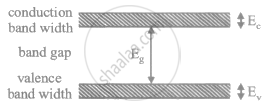Advertisements
Advertisements
Question
In a transistor,
Options
the emitter has the least concentration of impurity
the collector has the least concentration of impurity
the base has the least concentration of impurity
all the three regions have equal concentrations of impurity.
Solution
the base has the least concentration of impurity
When the emitter of a transistor is forward biassed, the majority carriers move from the emitter to the collector through the base. As the base is thin and lightly doped, only small amount of a combination of electrons and holes takes place, leading to weak base current. This makes the collector current equal to the emitter current.
If we make any other choice for least concentration of impurity, we will have a low value of collector current. Thus, the purpose of a transistor will not be fulfilled.
APPEARS IN
RELATED QUESTIONS
Write two characteristic features to distinguish between n-type and p-type semiconductors ?
Distinguish between a conductor, a semiconductor and an insulator on the basis of energy band diagrams.
There are energy bands in a solid. Do we have really continuous energy variation in a band ro do we have very closely spaced but still discrete energy levels?
The conduction band of a solid is partially filled at 0 K. Will it be a conductor, a semiconductor or an insulator?
In semiconductors, thermal collisions are responsible for taking a valence electron to the conduction band. Why does the number of conduction electrons not go on increasing with time as thermal collisions continuously take place?
When an electron goes from the valence band to the conduction band in silicon, its energy is increased by 1.1 eV. The average energy exchanged in a thermal collision is of the order of kT which is only 0.026 eV at room temperature. How is a thermal collision able to take some to the electrons from the valence band to the conduction band?
What is the resistance of an intrinsic semiconductor at 0 K?
An electric field is applied to a semiconductor. Let the number of charge carries be nand the average drift speed by v. If the temperature is increased,
The electrical conductivity of pure germanium can be increased by
(a) increasing the temperature
(b) doping acceptor impurities
(c) doping donor impurities
(d) irradiating ultraviolet light on it.
Calculate the number of states per cubic metre of sodium in 3s band. The density of sodium is 1013 kgm−3. How many of them are empty?
In a pure semiconductor, the number of conduction election 6 × 1019 per cubic metre. How many holes are there in a sample of size 1 cm × 1 mm?
Indium antimonide has a band gap of 0.23 eV between the valence and the conduction band. Find the temperature at which kT equals the band gap.
The conductivity of a pure semiconductor is roughly proportional to T3/2 e−ΔE/2kT where ΔE is the band gap. The band gap for germanium is 0.74 eV at 4 K and 0.67 eV at 300 K. By what factor does the conductivity of pure germanium increase as the temperature is raised from 4 K to 300 K?
What is forbidden band?
If the lattice constant of this semiconductor is decreased, then which of the following is correct?

The energy of a hydrogen atom in the ground state is −13.6 eV. The energy of a He+ ion in the first excited state will be:
A hole in a. p – type semiconductor is
A semiconductor is cooled from T.K to T2K its resistance will
In a semiconductor, the forbidden energy gap between the valence, band and the conduction band is of the order of
Three photo diodes D1, D2 and D3 are made of semiconductors having band gaps of 2.5 eV, 2 eV and 3 eV, respectively. Which 0 ones will be able to detect light of wavelength 6000 Å?
